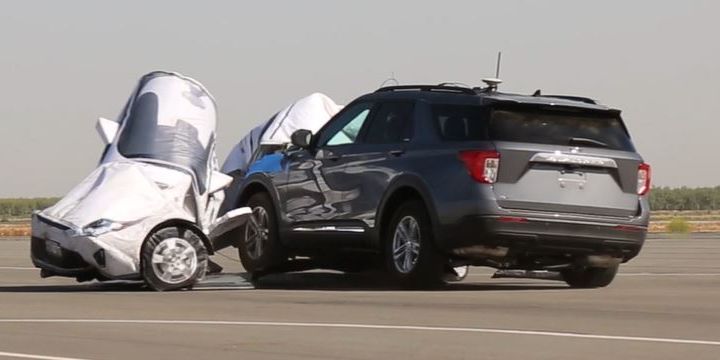AAA Study Finds Automated Emergency Braking Systems Have Flaws

Automated emergency braking, known by many names at different automakers, is almost universally standard on new vehicles in the U.S. today, but that doesn’t mean they prevent all types of rear-end collision.Official AEB tests are done at just 12 and 25 miles per hour. AAA decided to see if they worked as well at 30 and 40 mph. They did not.AAA’s results are extremely similar to a test we did three years ago on these systems.
Automated emergency braking might sound like a technology that automatically brakes your car in an emergency. Logical, sure, but the AAA just released results of a test that it performed showing that relying on AEB isn’t as predictably safe as drivers might expect. Especially when moving at speeds above 40 mph, AEB’s full functionality dropped to worrying levels, the not-for-profit association said. This came as no surprise to us, as we performed a test of these systems three years ago and found them similarly lacking.
Different automakers sometimes call their AEB technology by different names, but they all work similarly. Forward-facing sensors, which can include radar and cameras, scan the road ahead and when they detect something the moving vehicle might crash into, the system applies the brakes in an attempt to, well, not crash.
In 2016, the majority of major automakers agreed to make AEB technology standard on their vehicles by 2022. Today, 20 automakers, builders of more than 99 percent of the new vehicles in the U.S., have made AEB standard equipment on all models.
AAA and other safety groups acknowledge that AEB works. Last year, the Insurance Institute for Highway Safety (IIHS) released a new study that found rear AEB helped reduce the number of insurance claims more than any other safety technology the group had studied. But preventing rear-end crashes at slower speeds, which is what AEB was originally designed to do, is not the only thing that AEB could be used for. AAA said that, between 2016 and 2020, almost 40 percent of all fatalities involving two passenger vehicles, when the striking vehicle did not lose traction or leave the road before the collision, were T-bones and left turns in front of oncoming vehicles. AEB systems also have difficulty working at night, as IIHS discovered earlier this year.
“Automatic emergency braking does well at tackling the limited task it was designed to do,” Greg Brannon, director of AAA’s automotive engineering and industry relations, said in a statement. “Unfortunately, that task was drawn up years ago, and regulators’ slow-speed crash standards haven’t evolved. Testing requirements for this technology, or any vehicle safety system for that matter, must be updated to handle faster, more realistic speeds and scenarios with the greatest safety benefit for drivers.”
AAA

AAA
To figure out how well AEB technologies work at intersections and at higher speeds, AAA decided to conduct a new series of tests using vehicles from four automakers: a 2022 Chevrolet Equinox LT, a 2022 Ford Explorer XLT, a 2022 Honda CR-V Touring and a 2022 Toyota RAV4 LE. Current crash standards require AEB tests to be conducted at 12 and 25 mph, not exactly highway speeds. AAA instead ran tests where a vehicle moving at 30 or 40 mph hit a stationary vehicle. The group also ran T-bone and unprotected-left-turn tests.
AEB prevented a rear-end collision 85 percent of the time when tested at 30 mph. This number dropped to just 30 percent for tests at 40 mph. In the intersection tests, AEB completely failed. Crashes occurred in 100 percent of AAA’s tests because “AEB failed to alert the driver, slow the vehicle’s speed, [or] avoid the crash.”
It Still Helps in Some Ways
Despite these low success rates, AEB is still a valuable technology to have, AAA found, because even if it can’t completely avoid a crash, AEB systems can still slow a car down enough to reduce the severity of a crash. In the 30-mph test, impact speed was reduced by 86 percent; at 40 mph, it was by 62 percent.
Automakers have been adjusting their AEB technologies in response to customer complaints about “inadvertent activation” and for other reasons. Test results in hand, AAA is now calling on automakers to get their safety systems “to better handle the types of crashes when injuries and fatalities commonly occur,” including getting AEB to handle intersection-based crash scenarios. Just as important is the message that drivers should not rely on an AEB system working as promised in an emergency.
This content is imported from OpenWeb. You may be able to find the same content in another format, or you may be able to find more information, at their web site.



